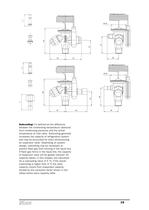 Website:
CASTEL
Website:
CASTEL
Catalog excerpts

Expansion valves
Open the catalog to page 1
16 diaphragm assembly by 1.5 meter length of capillary tubing, which transmits bulb pressure to the top of the valve’s diaphragm. The sensing bulb pressure is a function of the temperature of the thermostatic charge that is the substance within the bulb. The body is made from forged brass with connection in angle configuration. The interchangeable orifice assembly can be replaced through the inlet connection. A steel rod, inside the body, transfers the diaphragm movement to the plug inside the orifice assembly. When the thermostatic charge pressure increases, the diaphragm will be deflected...
Open the catalog to page 2
18 charge cannot incorporate MOP functions. Gas charge: the behaviour of valves with gas charge will be determined by the lowest temperature at any part of the expansion valve (thermostatic element, capillary tube or bulb). If any parts other than the bulb are subjected to the lowest temperature, malfunction of expansion valve may occur (charge migration). Castel thermostatic expansion valves with gas charge always feature MOP functions and include ballasted bulb. Ballast in the bulb has a damping effect on the valve regulation and leads to slow opening and fast closure of the valve. MOP...
Open the catalog to page 4
19 Subcooling: it’s defined as the difference between the condensing temperature (deduced from condensing pressure) and the actual temperature at inlet valve. Subcooling generally increases the capacity of refrigeration system and may be accounted for when dimensioning an expansion valve. Depending on system design, subcooling may be necessary to prevent flash gas from forming in the liquid line. If flash gas forms in the liquid line, the capacity of expansion valve will be greatly reduced. All capacity tables, in this chapter, are calculated for a subcooling value of 4 °C; if the actual...
Open the catalog to page 5
20 chosen refrigerant. Step 4 Select a thermostatic charge. Chose the type of charge, liquid without MOP or gas with MOP, and the temperature range, normal temperature or low temperature. Step 5 Determine if external equalizer is required. External equalizer is always required if a distributor is used or if there is an appreciable difference in pressure from the valve outlet to the bulb location. Finally determine the type of connections and their sizes. Step 6 Order the required components If SAE Flare connections you have to order the following two parts: - Body assembly (see tabs 1a/1b)...
Open the catalog to page 6
21 • pressure drop across the valve = 4,2 bar • evaporating temperature = - 10 °C • calculated evaporator capacity = 5,55 kW • select the corresponding orifice 2205 (N.B.: the expansion valve capacity must be equal or slightly more than the calculated evaporator capacity) MARKING Main valve data are indicated on the upper side of the thermostatic element and on the cartridge surface of the orifice assembly. On the thermostatic element you may find the following data: • The valve code number • The refrigerant • The evaporating temperature range • The MOP value, if present • The maximum...
Open the catalog to page 7
26 PWM SOLENOID EXPANSION VALVE WITH INTERCHANGEABLE ORIFICE APPLICATION Solenoid expansion valve Castel type 2028 regulates the refrigerant flow into the evaporator by modulating the opening time phase of the plug and so permitting a wide range of power. This valve must be used with a coil type HM4 (see table 2), controlled by an electronic regulator device (not supplied by Castel). This valve is most frequently used in refrigeration systems, in particular refrigerated cabinets in the supermarket, which use refrigerant fluids proper to the Group II (as defined in Article 9, Section 2.2 of...
Open the catalog to page 12
27 TABLE 1: General Characteristics of PWM solenoid expansion valves Catalogue number 0,5 0,01 0,07 0,017 0,8 0,023 1,1 0,043 1,3 0,065 1,7 0,113 2,3 0,2 Orifice Flow [mm] Kv Factor [m3/h] MinOPD 0 18 PWM (Pulse Width Modulating) 1 -40 100 45 Art. 3.3 MOPD AC/RAC DC Operating principles Minimum working time [s] Opening pressure differential [bar] min max PS [bar] TS [°C] ODS Connections [in] [mm] IN OUT IN OUT Risk Category according to PED 2028/3S01 3/8” 1/2” – – 2028/M10S01 – – 10 12 2028/3S02 3/8” 1/2” – – 2028/M10S02 – – 10 12 2028/3S03 3/8” 1/2” – – 2028/M10S03 – – 10 12 2028/3S04 3/8”...
Open the catalog to page 13
28 a given evaporating temperature. If necessary, correct the evaporator capacity for subcooling. Subcooling liquid refrigerant entering the evaporator increase the evaporator capacity, so that a smaller valve may be required. The subcooling is calculated by the formula: From the subcooling corrector factor table find the appropriate corrector factor Fsub corresponding to the ÄTsub calculated and determine the required valve capacity by the formula: Qsub = Fsub . Qe Step 3 Application correction. To obtain a correct regulation with this valve, is necessar y to oversize it so its closing...
Open the catalog to page 14All CASTEL catalogs and technical brochures
-
CASTEL - 2013 General Catalogue
105 Pages
-
VALVES FOR REFRIGERATING SYSTEMS
34 Pages
-
REFRIGERATING SYSTEMS PROTECTORS
38 Pages
-
OIL CONTROL SYSTEM
22 Pages
-
PRODUCTS FOR CO2 SYSTEMS
7 Pages
-
Products catalogue
101 Pages
Archived catalogs
-
Products Catalogue 2008
84 Pages
-
Threaded brass fittings
10 Pages
-
Valves
20 Pages
-
Oil separators
6 Pages
-
Dehydrators and Filters
28 Pages
-
Water regulating valves
6 Pages
-
Check valves
6 Pages
-
Safety devices
16 Pages
-
Solenoid valves
18 Pages

























